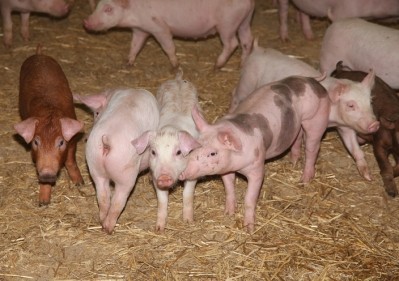Growth of pigs fed protected ZnO at lower dose comparable to high dose ZnO: study

The researchers saw comparable or better results than conventional ZnO dosages when supplementing the weaning pig diet with with lower dose, protected ZnO on growth performance, digestibility of nutrients and reduced faecal Zn concentration in weaning pigs.
The findings were published in Animal Feed Science and Technology.
The scientists said the lower level of ZnO used in the weaning pigs’ diets would have both economic and environmental benefits.
“Protected zinc in lower doses could be used in weaned pigs in substitution for the conventional high dose zinc oxide as a growth promoter [and it] may contribute to reduce Zn enriched slurry in pig facilities.”
The ZnO used in the study was a commercial product that was protected using lipid matrix coating; it contained 40% ZnO and 60% hydrogenated palm oil.
Background
The authors noted the stress related changes in weaning pigs and how, to alleviate post-weaning diarrhea, ZnO, has been used in large doses - up to 3000 mg/kg - for the prevention and treatment of diarrhea in weaned pigs (Shen et al., 2014; Cho et al., 2015).
“High doses of ZnO were perceived to possess antimicrobial property and could alleviate diarrhea by reducing enterotoxigenc E.coli colonization and bacterial population in the gastro-intestinal tract (Fairbrother et al., 2005).
“However, the effects of high doses of ZnO on intestinal microbiome are not equivocal. For instance, some studies indicated that 2500–3000 ppm of dietary ZnO may increase E. coli population in gastro-intestinal tract and induce diarrhea (Hojberg et al., 2005; Molist et al., 2011; Pieper et al., 2012).
“In addition, the use of ZnO in higher doses has been criticized worldwide due to the negative effects [on the] environment resulting from zinc-enriched slurry due to which the use of Zn in large dose has to be eventually reduced (EFSA, 2010).”
They said the reason for usage of large doses is because most of the ZnO gets solubilized in the stomach due to acidic pH and only a small amount of insoluble Zn in the form of Zn ions reaches the animal's intestine which is an active site of action.
The researchers noted that efforts are underway to reduce the usage of higher doses of ZnO in pig feed and to enhance the biological effect of ZnO in reducing the incidence of diarrhea. “In the recent years, the modification of regular ZnO powder into porous particles or nanoparticles is a common practice.”
The Korean team hypothesized that if ZnO is protected by coating, it may reduce the dissociation of ZnO in the stomach and allow the delivery of protected ZnO in an undissociated form to the distal GI tract for effective absorption (Shen et al., 2014).
Method
The team said a total of 150 crossbred weaning pigs (28 days old) with an average body weight (BW) of 6.48 ± 1.58 kg were blocked and stratified based on sex and randomly allotted to 1 of 6 dietary treatments [5 pigs per pen (2 barrows and 3 gilts); 5 pens per treatment] for a 6-week trial in two phases.
Treatments consisted of basal diet (NC); Basal diet without Zn in mineral premix with either 2500 ppm unprotected ZnO (PC) or 250, 500, 750 and 1000 ppm protected ZnO (PZ1, PZ2, PZ3 and PZ4 respectively).
Results
The researchers found the growth performance in pigs fed protected ZnO diets was comparable with PC diet during phase 1 and 2, except for G/F ratio in phase 1.
They noted cubic effects of protected ZnO dose on average daily gain (ADG) and average daily feed intake (ADFI) during phase 2. The coefficient of apparent total tract (CAATD) nutrient digestibility in pigs fed protected ZnO diets was comparable with PC diet, they said. The concentration of Zn in the serum of pigs fed PC diet was higher than protected ZnO diets during week 1, 3 and 6, they added.
The researchers said the faecal Zn concentrations were higher in pigs fed PC diets compared to NC and PZ diets during week 1, 3 and 6. A linear response of protected ZnO dose was observed on faecal Zn concentration.
The E.coli and Clostridium spp counts were lower in the digesta from colon of pigs fed PC diet than protected ZnO diets during week 3.
They found that quadratic and cubic effects of protected ZnO dose were observed on E.coli counts in the digesta of ileum and colon of pigs. Linear effects of protected ZnO dose were observed on Lactobacillus and Clostridium counts on the digesta of ileum and colon respectively.
The researchers said faecal E.coli counts were greater in protected ZnO than in conventional ZnO during week 1 and 3, while the faecal Lactobacillus counts were greater and Salmonella counts were lower in PZ1 and PZ2 diets than PC diets during week 6. They saw that linear and quadratic effects of protected ZnO dose on E.coli counts during week 3 and linear effects on Lactobacillus and Salmonella counts during week 6 were observed.
In summary, the team found the growth performances in pigs fed protected ZnO at lower dose were comparable to high dose conventional ZnO, and that nutrient digestibility was also comparable in pigs fed protected vs conventional ZnO, while the fecal Zn concentration was reduced in protected versus conventional ZnO treatment.
Source: Animal Feed Science and Technology.
Title: Use of protected zinc oxide in lower doses in weaned pigs in substitution for the conventional high dose zinc oxide
DOI: doi.org/10.1016/j.anifeedsci.2018.03.012
Authors: SD Upadhaya, YM Kim, KY Lee, IH Kim









